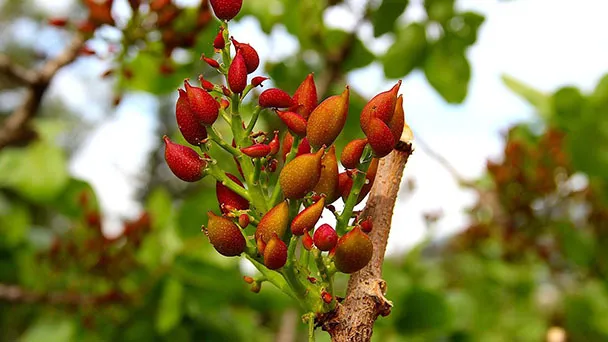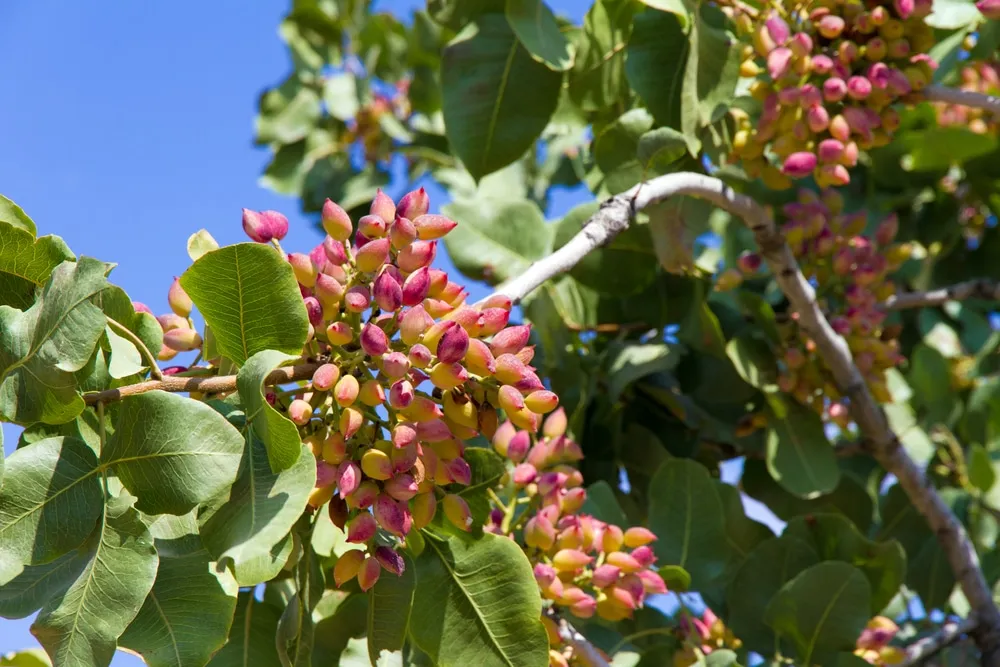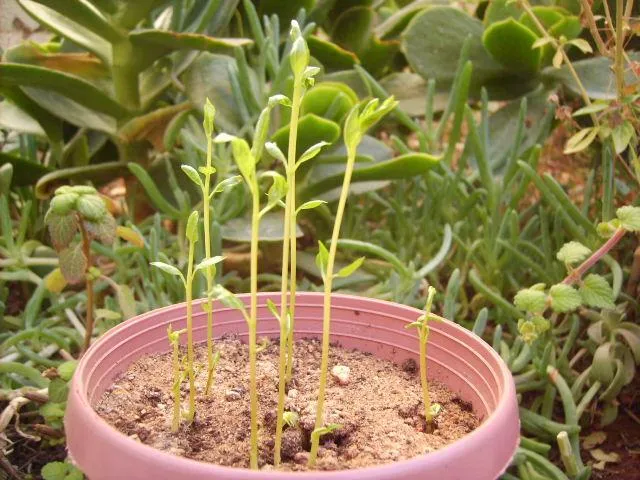Where and How Do Pistachios Grow - Pistachio Nut Trees Care
Written by Ivy
Jan 30 2023

Where and how do pistachios grow? Pistachios' shell is half open and its core is red. They seem to be laughing. Pistachios not only looks friendly, but it is rich in fat beneficial to the heart, but it is still the most beneficial of many nuts. How does pistachios grow and endure some very challenging environments?
 Many people have never seen what pistacios trees grows on. In fact, it is called Pistacia vera L, which is native to Syria, Iran and other regions.
Many people have never seen what pistacios trees grows on. In fact, it is called Pistacia vera L, which is native to Syria, Iran and other regions.
Pistacia vera L's vitality is still very tenacious. It is resistant to drought, cold and barren. It can grow in almost all soil. It is an excellent tree for soil and water conservation. Seeing these growth habits, you may wonder why we can't plant a large number of trees that are so easy to plant, so the pistacios we eat won't be so expensive. (Read More: Where Do Pistachios Come from?)
Although Pistacia vera L has entered the full fruit period, it is very tall and difficult to harvest. The key point is that although it is the full fruit period, the output of pistacios is still very limited. Generally, the output of Pistacia vera L in the full fruit period is more than 100 kg of fresh fruit. Such a low output naturally needs to be supported by high prices, So that fruit farmers can see benefits.
In fact, not only the amount of results is relatively low, but also the investment in the early stage is very large. First, we need to wait for at least 6 years for Pistacia vera L to grow fruit. During this period, we need the continuous investment of growers. In addition, if we plant Pistacia vera L, we still need to take a lot of risks, because Pistacia vera L mostly grows in Xinjiang, few are introduced in other regions, and lack planting management experience, so many fruit farmers dare not rashly try to plant Pistacia vera L. Therefore, these reasons also lead to a relatively small planting area of pistachios, and many fruit farmers are unwilling to plant such trees, so that the market price of pistachios has been maintained at a high level.
Read More: Usually, the shell of naturally mature pistachios will crack automatically. If pistachios has high maturity and full fruit, its opening will be large. If the maturity is poor, the opening of pistachios will be small or even No. In order to improve profits, some businesses will pick pistachios in advance. We can open pistachios manually, but the artificial opening is still smaller than the natural opening. We should give priority to the types with larger openings when buying. The larger the opening of pistachios, the easier it is to peel off and it will be more convenient to eat. Therefore, we should give priority to pistachios with larger opening when selecting.
Usually, the shell of naturally mature pistachios will crack automatically. If pistachios has high maturity and full fruit, its opening will be large. If the maturity is poor, the opening of pistachios will be small or even No. In order to improve profits, some businesses will pick pistachios in advance. We can open pistachios manually, but the artificial opening is still smaller than the natural opening. We should give priority to the types with larger openings when buying. The larger the opening of pistachios, the easier it is to peel off and it will be more convenient to eat. Therefore, we should give priority to pistachios with larger opening when selecting.
What Tree Does Pistachios Grow on?Why is Pistachios so Expensive and Few People Grow It?Did pistachios crack naturally?Is the Smoother the Opening Edge of Pistachios the Better?How Do We Tell If Pistachios Cracks Naturally?What Therapeutic Effect Does Pistachios Have?1. Vitamin E2. Oleic Acid
What Tree Does Pistachios Grow on?

Pistacia vera L's vitality is still very tenacious. It is resistant to drought, cold and barren. It can grow in almost all soil. It is an excellent tree for soil and water conservation. Seeing these growth habits, you may wonder why we can't plant a large number of trees that are so easy to plant, so the pistacios we eat won't be so expensive. (Read More: Where Do Pistachios Come from?)
Why is Pistachios so Expensive and Few People Grow It?
Because Pistacia vera L has a very famous feature - the growth rate is very slow. It takes at least six years to make a Pistacia vera L blossom and bear fruit, and the amount of fruit of Pistacia vera L in the initial fruit stage is very small. During this period, we have to wait continuously until pistacios grows to about 20 years before we can produce a large number of results, Enter the full fruit period of pistachios. (Read More: Why Are Pistachios So Expensive)Although Pistacia vera L has entered the full fruit period, it is very tall and difficult to harvest. The key point is that although it is the full fruit period, the output of pistacios is still very limited. Generally, the output of Pistacia vera L in the full fruit period is more than 100 kg of fresh fruit. Such a low output naturally needs to be supported by high prices, So that fruit farmers can see benefits.
In fact, not only the amount of results is relatively low, but also the investment in the early stage is very large. First, we need to wait for at least 6 years for Pistacia vera L to grow fruit. During this period, we need the continuous investment of growers. In addition, if we plant Pistacia vera L, we still need to take a lot of risks, because Pistacia vera L mostly grows in Xinjiang, few are introduced in other regions, and lack planting management experience, so many fruit farmers dare not rashly try to plant Pistacia vera L. Therefore, these reasons also lead to a relatively small planting area of pistachios, and many fruit farmers are unwilling to plant such trees, so that the market price of pistachios has been maintained at a high level.
Read More:
Did pistachios crack naturally?

Is the Smoother the Opening Edge of Pistachios the Better?
The opening edge of pistachios with natural opening is usually flat without obvious bending radian. Pressing the opening by hand usually can not close, and the opening can not be completely closed. The opening edge of pistachios with artificial opening is usually uneven and the radian is obvious. It can be completely closed by pressing with hands. We can distinguish it in this way during selection.How Do We Tell If Pistachios Cracks Naturally?
Generally, when pistachios is mature, its shell will automatically crack. It can be said that this is a symbol of maturity. If it is not mature, it means it can't be eaten. Nowadays, many processors will clamp pistachios without openings with external force, so we must pay attention to selection at this time. After careful observation, it can be found that the opening edge of the shell of such fruit often bends unevenly, or the pistachios shell can be closed. If it can be completely closed or there is only a small seam, it is opened manually. Generally, natural openings often split a large seam, and they can never be completely closed.What Therapeutic Effect Does Pistachios Have?
1. Vitamin E
Most nuts, including pistachios (except chestnuts, lotus seeds and other varieties with high starch content), are rich in vitamin E. In nuts, vitamin E with strong antioxidant effect can protect unsaturated fatty acids from oxidation; In the human body, the antioxidant effect of vitamin E in pistachios helps to delay aging, maintain skin, anti atherosclerosis and so on.2. Oleic Acid
Oleic acid is the most important monounsaturated fatty acid, which is not common or low in daily oil or other foods. Compared with linoleic acid and linolenic acid, the common polyunsaturated fatty acids in daily oil or food, oleic acid has better health benefits: oleic acid in pistachios can not only reduce blood total cholesterol (TC) and low-density lipoprotein cholesterol (LDL-C, which belongs to "bad" cholesterol and is the primary pathogenic factor of atherosclerosis), but also increase high-density lipoprotein cholesterol (HDL-C belongs to "good" cholesterol, which helps to prevent the occurrence and development of atherosclerosis), so it is considered to be the fatty acid most beneficial to the health of cardiovascular and cerebrovascular system.Latest Updated
- Where and How Do Pistachios Grow - Pistachio Nut Trees Care
- How to Grow & Care for Pistachio Trees
- Pistachio Tree Profile
- Hong Kong Orchid Tree Problems: Diseases And Remedies
- Hong Kong Orchid Tree Pros And Cons - How Fast Does It Grow
- How to Grow and Care for Hong Kong Orchid Tree
- How to Propagate Hong Kong Orchid Tree
- Hong Kong Orchid Tree Profile
- Why Are Pistachios So Expensive - 4 Main Reasons
- Health Benefits of Pistachios - Nutrition Facts & How Does It Work
Popular Articles
- Winter maintenance of Antirrhinum Majus
- How to Grow Terminalia Mantaly Tree
- How to Grow and Care for Crossostephium Chinense
- How to grow Antirrhinum Majus in spring
- Peristeria Elata (Dove Orchid) Profile: Info & Care Guide
- Underwatered Snake Plant (Sansevieria Trifasciata) - Signs And How To Fix
- How to Care for Brazilian Jasmine Plant (Mandevilla Sanderi)
- How to Grow & Care for Graptopetalum Purple Delight in Summer
- Rosa Chinensis (China Rose): Plant Growing & Care Tips
- How to Care for Baby Sun Rose (Aptenia Cordifolia)